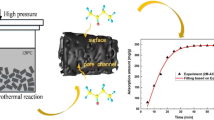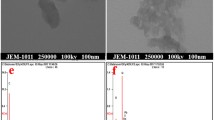Abstract
To enhance nitrobenzene removal from aqueous solution, commercial activated carbon (AC) was modified by oxidation with HNO3 followed by heat treatment in a nitrogen atmosphere. The modification process introduced oxygen-containing functional groups and changed the charge properties of the AC surface. The effects of surface chemical properties and pore structure on the adsorption of nitrobenzene by the AC were investigated through kinetics and equilibrium isotherms. HNO3 oxidation modified the surface chemical properties and increased the number of acidic oxygen-containing surface groups, but had an almost negligible effect on the pore structure. Subsequent heat treatment caused decomposition of oxygen-containing functional groups on the AC surface, increased the pH point of zero charge (pHPZC) and increased the number of mesopores. The maximum adsorption capacity achieved by the modified AC was 1,443.53 mg g−1, 3.33 times of that unmodified AC. HNO3 oxidation combined with heat treatment was an effective method for the preparation of AC with high nitrobenzene adsorption capacity and fast adsorption kinetics. An appropriate pHPZC, amount of surface oxygen groups and the presence of well-developed mesopores together with micropores were the main reasons for the high nitrobenzene adsorption capacity of the modified AC.






Similar content being viewed by others
References
J.S. Mattson, H.B. Mark, Activated Carbon Surface Chemistry and Adsorption from Solution (Marcel Dekker, New York, 1971)
C.Y. Yin, M.K. Aroua, W.M. Ashri, Sep. Purif. Technol. 52, 40 (2007)
F.M. Tennant, D.W. Mazyck, Carbon 45, 858 (2007)
A.D. Marczewska, J. Goworek, A. Swiaztkowski, B. Buczek, Carbon 42, 301 (2004)
I.I. Salame, T.J. Bandosz, J. Colloid Interface Sci. 264, 307 (2003)
E. Muller, K. Gubbins, Carbon 36, 1433 (1998)
S.X. Liu, X. Chen, X.Y. Chen, H.L. Wang, Z.F. Liu, J. Hazard. Mater. 141, 315 (2007)
J.T. Bandosz, Carbon 37, 483 (1999)
C.C. Huang, H.S. Li, C.H. Chen, J. Hazard. Mater. 159, 523 (2008)
M. Franz, H.A. Arafat, N.G. Pinto, Carbon 38, 1807 (2000)
J. Rangal-Mendez, F. Cannon, Carbon 43, 467 (2005)
L.R. Radovic, I.F. Silva, J.I. Ume, Carbon 35, 1339 (1997)
F. Villacañas, M. Pereira, J. Órfão, J. Colloid Interface Sci. 293, 128 (2006)
A. Contescu, C. Contescu, K. Putyera, J.A. Schwarz, Carbon 35, 83 (1997)
F. Haghseresht, S. Nouri, G.Q.M. Lu, Carbon 41, 881 (2003)
C.O. Ania, J.B. Parra, J.J. Pis, Fuel Process. Technol. 79, 265 (2002)
Y. El-Sayed, J.T. Bandosz, J. Colloid Interface Sci. 273, 64 (2004)
M. Chen, L. Cui, C.H. Li, G.W. Diao, J. Hazard. Mater. 162, 23 (2009)
Y. Kato, M. Machida, H. Tatsumoto, J. Colloid Interface Sci. 322, 394 (2008)
S. Kodama, H. Sekiguchi, Thin Solid Films 506–507, 327 (2006)
C.T. Hsieh, H. Teng, Carbon 38, 863 (2000)
B.M. Babić, S.K. Milonjić, M.J. Polovina, B.V. Kaludierovic, Carbon 37, 477 (1999)
I.I. Salame, T.J. Bandosz, J. Colloid Interface Sci. 240, 252 (2001)
S.N. Joong, J.A. Schwarz, Carbon 28, 675 (1990)
D.D. Do, Chem. Eng. Sci. 51, 4145 (1996)
G. Drazer, R. Chertco, L. Bruno, M. Rosen, Chem. Eng. Sci. 54, 4285 (1999)
M.J.G. Linders, L.J.P. Broekeb, T.A. Nijhuisc, F. Kapteijnc, J.A. Moulijn, Carbon 39, 2113 (2001)
H.D. Do, D.D. Do, I. Prasetyo, Chem. Eng. Sci. 56, 4351 (2001)
D.P. Xu, S.H. Yoon, I. Mochida, W.M. Qiao, Y.G. Wang, L.C. Ling, Microporous Mesoporous Mater. 115, 461 (2008)
Acknowledgments
This project was financially supported by the Distinguished Young Scientist Foundation of Heilongjiang Province (JC200801) and the National Natural Science Foundation of China (No. 30771692).
Author information
Authors and Affiliations
Corresponding author
Rights and permissions
About this article
Cite this article
Liu, S., Wang, R. Modified activated carbon with an enhanced nitrobenzene adsorption capacity. J Porous Mater 18, 99–106 (2011). https://doi.org/10.1007/s10934-010-9360-x
Published:
Issue Date:
DOI: https://doi.org/10.1007/s10934-010-9360-x




